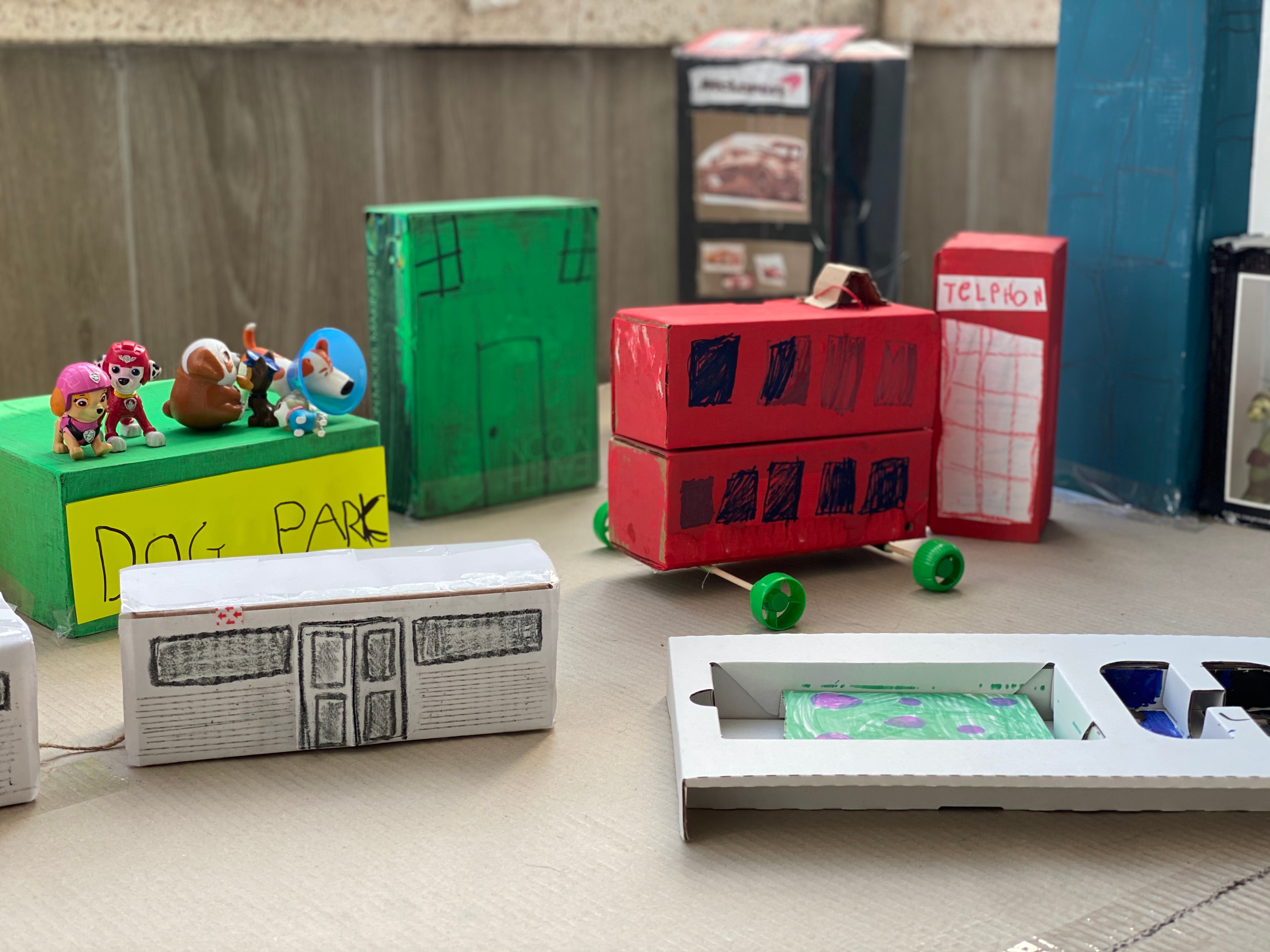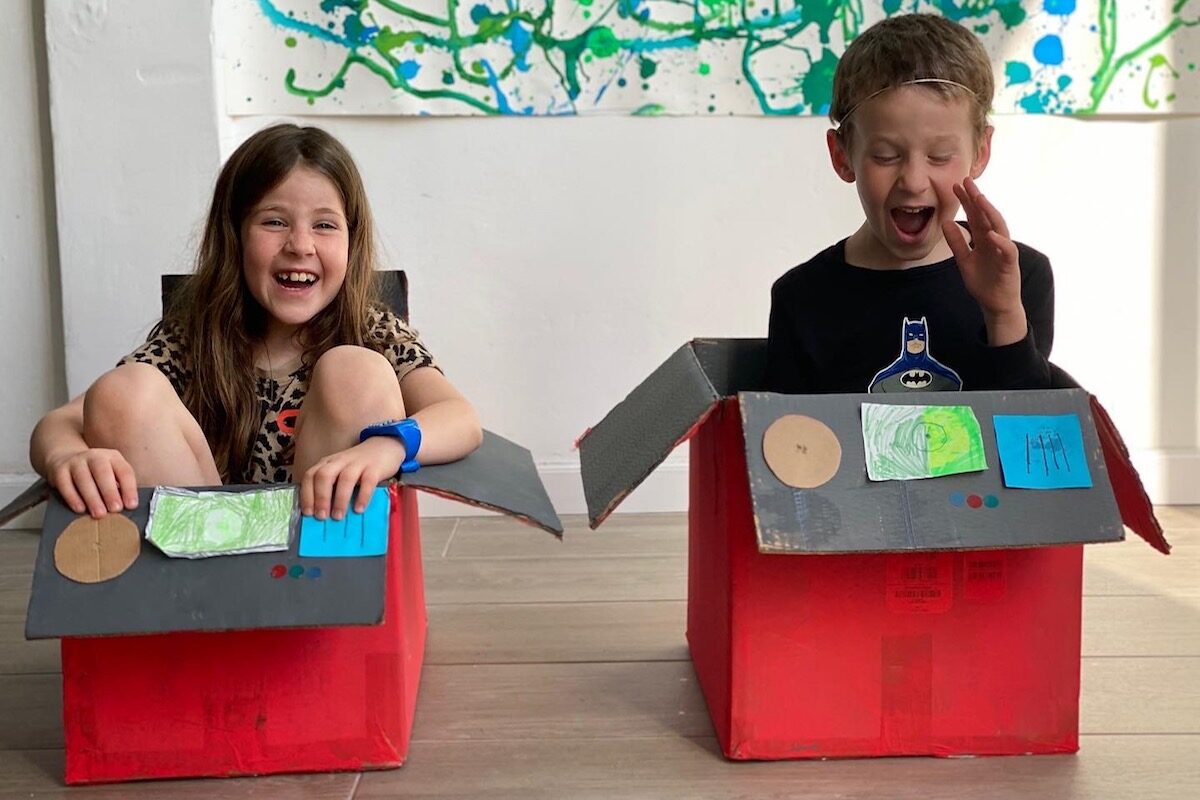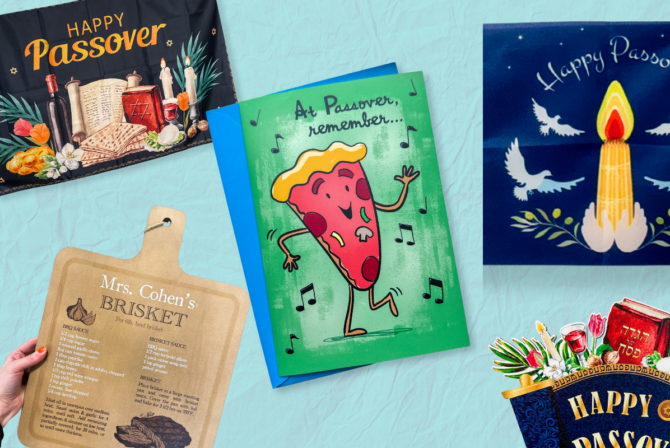About three days into quarantine — just long enough to figure out that distance learning is not working for our family — we begin creating a miniature town out of recycled cardboard boxes. The buildings start out as rectangular offices and generic houses but very quickly grow more elaborate. My 7-year-old daughter, Zoe, makes a Lamborghini store, inspired by her newfound sports car obsession; my 5-year-old son transforms an egg carton into the bus he so desperately wishes he could take back to his nursery school.
The project takes on a life of its own, and, before I know it, there is a growing mountain of old boxes piling up in the corner of our living room, waiting to be transformed.
One day, Zoe asks me if she can use one of the boxes for something other than the town. “Of course!” I answer. For days, she tinkers with her little box, only involving one of us to occasionally ask whether or not we have an obscure material lying around the house. When she isn’t making supply requests, Zoe is walking around the house, hawking her product like it’s a promo for Shark Week. She produces several different prototypes of what she calls the Beatbox Watch — her version of a smartwatch, complete with storage and a voice recorder — each one increasing in innovation and technological sophistication.
Thus begins Zoe’s complex and intense relationship with cardboard. For days, she continues to putter around with various scraps, painting, cutting, and gluing them together, stretching the limits of her creativity and crafting skills. But it isn’t until around the third week of lockdown that Zoe discovers the healing powers of this seemingly innocuous material. One evening, after a particularly gruesome battle over a school assignment, Zoe slams the door to her room, much to the dismay of our downstairs neighbors. After a few alarmingly quiet minutes, the door cracks open, and a box with a small slot cut out of it comes sliding towards me. Across the top of the box, in big angry letters, is one word: POST.
“I’M NOT TALKING TO YOU!” she shrieks from the bedroom. Then, only nominally more calmly, she adds, “But if there’s something you need to say to me, put it in the postbox!”
And so, I write her a letter. I include in it all the things I wish I had remembered to say mid-tantrum that I was too angry to express, and all things I wanted to say post-tantrum that she wasn’t ready to hear. “Dear Zoe. This is SO hard, huh? Please know it’s hard for me, too. This is such a strange and new situation for all of us. But we are going to figure it out together. And some moments will be hard, like last night. But some will be really fun and silly. I cannot wait to start over. Love you more than mac & cheese, Mommy.”
In the morning, she wakes up, excitedly runs to check her mailbox, and we do, in fact, get a brand-new start.
Zoe continues to throw herself into her cardboard creations. She makes a DIY Plinko game that we all enjoy playing and a spectacular rocket ship that, in a rare display of magnanimity, she voluntarily duplicates for her little brother. One day, my husband suddenly appears with a gigantic roll of corrugated cardboard. He wants to use it as the ground for our cardboard town, so we lay down huge sheets of it, covering nearly half of our living room, and begin to tape down the structures we already created. I catch Zoe gazing at the roll with a glimmer in her eye.

Her opportunity to make use of it comes several days later. When I have the audacity to tell her that, no, she cannot have ketchup with a side of ketchup for dinner, she loses it. A month’s worth of pent-up anger and sadness comes barreling towards me like a boulder. “I HATE LIVING HERE!” she screams as the tears start flowing, fast and furiously. “I’M MOVING OUT!” It is Passover time here in Israel. We are under our strictest round of lockdown orders, and my entire family is mourning the loss of what would have been our annual trip to America.
I want to rush over and hold her little body, let her tears mingle with mine. But I sense that’s not what she needs right now. Instead, she drags the roll of cardboard into her room, where she uses it to make herself “a new apartment” by rolling out a massive piece around the perimeter of her desk. She hangs up her mailbox, which is still seeing a lot of use, and she posts a sign that says “MOM, KEEP OUT.”
As she works, however, her anger dissipates. By the time she is done, she proudly invites me to inspect her new home. In the ensuing days, she uses her “studio apartment” for school Zoom meetings, quiet reading, and whenever she needs some alone time. What was born out of searing rage and frustration transforms into a space of joy and comfort. It is the perfect symbol of this emotional rollercoaster we are all riding together. The apartment stays up for a solid two weeks before she wordlessly takes it down to make room for a pillow fort.
As quarantine wears on, we do countless art projects and messy activities. There are really tough moments and exquisitely beautiful ones. Then one day, Zoe is suddenly looking for a small doll that I had thrown out weeks ago during one of my many self-care cleaning purges. She has neither mentioned nor played with the little finger puppet in years, and it had worn away to almost nothing. Nevertheless, she is inconsolable when she discovers it is gone, and I find myself in the dreaded and yet familiar place of wondering whether I have made a parenting mistake. But I also know that her meltdown is less about this long-abandoned puppet and more to do with her struggle to regain a sense of control.
Before I can explain myself, Zoe pushes past me and heads to the cardboard pile. She makes a quick tombstone for her dearly departed toy. “RIP PAPPET,” she writes, in her signature phonetic spelling. Then she drags a wooden stool next to the cardboard tombstone. Tears well up again and I see the weight of isolation and uncertainty bearing down on her. “This is a shiva house,” she tells me. “There should be cake.”
I cannot help but smile. Zoe lost her great grandmother only a month earlier but spent most of the week of shiva running around with her cousins. Clearly, she has internalized more than I realized. “You need to cover the mirrors,” she informs me. And so, I get to work setting up our house of mourning. I cover up her mirror with a bath towel and rustle up some cake. I even manage to borrow a few stones from her little brother’s rock collection to lay near the cardboard tombstone. I take Zoe’s hand as she sits on the low stool traditionally reserved for a Jewish mourner.
“I am trying not to be too sad,” she tells me.
“Me too,” I reply.
What is it that drives this powerful connection Zoe has to cardboard? Why have these discarded brown boxes and used packaging sheets been such an effective tool for helping her express, process, and release her emotions during this time? Perhaps it is because so many of cardboard’s physical properties mirror the personality traits that have carried Zoe through the last couple of months: Cardboard is both strong and yielding, just like my resilient yet sometimes flappable daughter. It is at once temporary, like the passing frustrations she has experienced while in lockdown, but also somehow permanent, like her unwavering sense of self.
Here in Israel, children have slowly started to return to school. Soon enough, our cardboard town will be demolished, whatever boxes remain from the pile will go out to the recycling bin, and the living room will revert to its original purpose. But I hope Zoe will carry this ability to use what she is given — no matter how raw the material — and transform it into her own personal source of strength, comfort, and joy with her as she transitions back into communal life.
Images courtesy of Rachel Shapiro Fink








